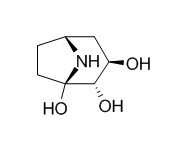Calystegine A3
Calystegines A3, B2, and C1 are glycosidase inhibitors. Calystegines A3 and B2 can effectively stabilize β-glucocerebrosidase, and consequently increase intracellular β-glucocerebrosidase activities in N370S fibroblasts.
Inquire / Order:
manager@chemfaces.com
Technical Inquiries:
service@chemfaces.com
Tel:
+86-27-84237783
Fax:
+86-27-84254680
Address:
1 Building, No. 83, CheCheng Rd., Wuhan Economic and Technological Development Zone, Wuhan, Hubei 430056, PRC
Providing storage is as stated on the product vial and the vial is kept tightly sealed, the product can be stored for up to
24 months(2-8C).
Wherever possible, you should prepare and use solutions on the same day. However, if you need to make up stock solutions in advance, we recommend that you store the solution as aliquots in tightly sealed vials at -20C. Generally, these will be useable for up to two weeks. Before use, and prior to opening the vial we recommend that you allow your product to equilibrate to room temperature for at least 1 hour.
Need more advice on solubility, usage and handling? Please email to: service@chemfaces.com
The packaging of the product may have turned upside down during transportation, resulting in the natural compounds adhering to the neck or cap of the vial. take the vial out of its packaging and gently shake to let the compounds fall to the bottom of the vial. for liquid products, centrifuge at 200-500 RPM to gather the liquid at the bottom of the vial. try to avoid loss or contamination during handling.
Earth Environ. Sci. 2021, 905:012080.
Planta Med.2018, 84(15):1101-1109
Pharmaceuticals (Basel).2024, ;17(8):1018.
Nutrients.2021, 13(1):254.
J. Pharm. Biomed. Anal.2024, 245:116193.
J. of Med. Plant Research.2013, 90-151
Journal of Third Military Medical University2018, 40(12):1073-1078
Plos One.2020, 10.1371
Chinese Pharmaceutical Journal2023, 58(2):178-187.
J of Apicultural Research2020, 10.1080
Related and Featured Products
Bioorg Med Chem. 2014 Apr 15;22(8):2435-41.
Docking and SAR studies of calystegines: binding orientation and influence on pharmacological chaperone effects for Gaucher's disease.[Pubmed:
24657053]
METHODS AND RESULTS:
Calystegine A3 bound to β-glucocerebrosidase with the same orientations as calystegine B2 (Type 1), while calystegine B3 and B4 had different binding orientations (Type 2). It is noteworthy that Type 1 orientated calystegines B2 and A3 effectively stabilized β-glucocerebrosidase, and consequently increased intracellular β-glucocerebrosidase activities in N370S fibroblasts, while Type 2 orientated calystegines B3 and B4 could not keep the enzyme activity.
Toxicol Pathol. 2008 Jul;36(5):651-9
The comparative pathology of the glycosidase inhibitors swainsonine, castanospermine, and calystegines A3, B2, and C1 in mice.[Pubmed:
18497426 ]
METHODS AND RESULTS:
To study various polyhydroxy-alkaloid glycosidase inhibitors, 16 groups of 3 mice were dosed using osmotic minipumps with swainsonine (0, 0.1, 1, and 10 mg/kg/day), castanospermine, and Calystegine A3, calystegine B2, and calystegine C1 (1, 10, and 100 mg/kg/day). After 28 days, the mice were euthanized, necropsied, and examined using light and electron microscopy. The high-dose swainsonine-treated mice developed neurologic disease with neuro-visceral vacuolation typical of locoweed poisoning. Castanospermine- and calystegines-treated mice were clinically normal; however, high-dose castanospermine-treated mice had thyroid, renal, hepatic, and skeletal myocyte vacuolation. Histochemically, swainsonine- and castanospermine-induced vacuoles contained mannose-rich oligosaccharides. High-dose calystegine A(3)-treated mice had increased numbers of granulated cells in the hepatic sinusoids. Electron microscopy, lectin histochemistry, and immunohistochemistry suggest these are pit cells (specialized NK cells). Histochemically, the granules contain glycoproteins or oligosaccharides with abundant terminal N-acetylglucosamine residues. Other calystegine-treated mice were histologically normal.
CONCLUSIONS:
These findings indicate that swainsonine produced lesions similar to locoweed, castanospermine caused vacuolar changes with minor changes in glycogen metabolism, and only Calystegine A3 produced minimal hepatic changes. These also suggest that in mice calystegines and castanospermine are less toxic than swainsonine, and as rodents are relatively resistant to disease, they are poor models to study such induced storage diseases.
Carbohydr Res. 2011 Dec 27;346(18):2855-61.
Chiral pool synthesis of calystegine A3 from 2-deoxyglucose via a Brown allylation.[Pubmed:
22088883]
Calystegine A3 is a naturally occurring nortropane iminosugar of which there previously have been three total syntheses.
METHODS AND RESULTS:
Inspired by our previous work we here report on a fourth approach using 17 steps from 2-deoxy-d-glucose applying a diastereoselective allylation protocol.



